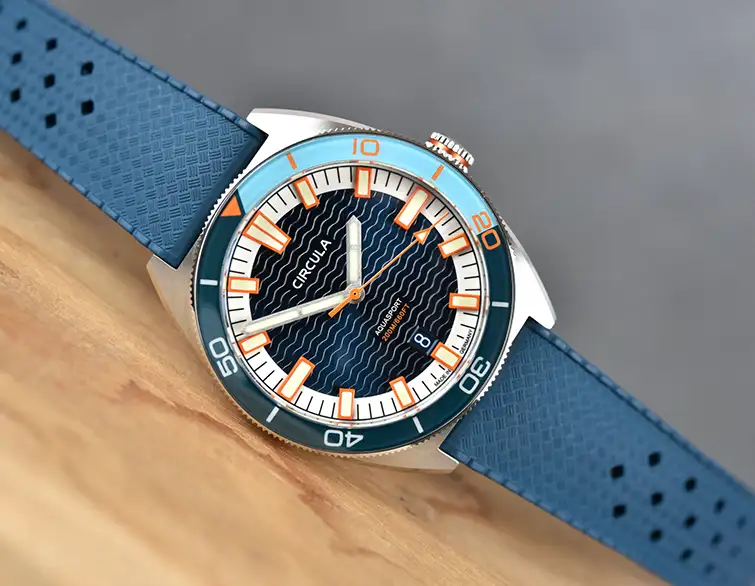Sapphire glass, mineral glass or Hesalite glass?
Advantages and disadvantages
Hesalite glass
mainly found in vintage watches
Hesalite crystals, which were widely used a few decades ago (e.g. in watches from the 1950s), are very rarely used today - although watch manufacturers occasionally still use domed Hesalite crystals in new models to emphasize their retro character. Compared to sapphire crystal, hesalite glass is around 50 times softer and therefore very scratch-sensitive, but on the other hand it is very elastic and therefore very shatterproof and impact-resistant. Superficial scratches can be polished out by yourself with a polishing paste (e.g. Polywatch) and a little patience.

Mineral glass
mostly hardened
From a chemical point of view, mineral glass is very similar to window glass - mineral glass is therefore naturally less shatterproof than hesalite glass. Today, mineral glass is usually used in watches, the surface of which is made more resistant by special manufacturing processes (e.g. by heating or vaporizing). Product descriptions often refer to hardened mineral glass. The coating gives the glass a hardness of around 900 HV (hardness according to Vickers), but it is still much more susceptible to scratches than sapphire crystal. Sapphire crystal the ultimate in scratch resistance The most resistant to scratches is sapphire crystal, although the name is somewhat misleading as sapphire crystal is not glass in the true sense of the word. Rather, it is a synthetic product that is manufactured from high-purity synthetic aluminum oxide using the complex Verneuil process. Sapphire glass achieves a hardness of around 2000 HV - twice as much as mineral glass. Sapphire glass can therefore only be scratched by a few materials, such as real diamond with 4,500 to 10,000 HV. By comparison, stainless steel has around 220 HV.
Sapphire glass
The ultimate in scratch resistance
Sapphire glass is the most resistant to scratches, although the term is somewhat misleading as sapphire glass is not glass in the true sense of the word. Rather, it is a synthetic product that is manufactured from high-purity synthetic aluminium oxide using the complex Verneuil process. Sapphire glass achieves a hardness of around 2,000 HV - twice as much as mineral glass.
Sapphire glass can therefore only be scratched by a few materials, such as real diamond with 4,500 to 10,000 HV. By way of comparison, stainless steel comes in at around 220 HV. One disadvantage of sapphire crystal is the comparatively strong refraction of light, which can lead to reflections that can limit the readability of a watch. To avoid this, sapphire crystals in high-quality watches, such as Circula, are double or double-sided anti-reflective. To be more precise, the inside and outside of the sapphire crystal of Circula watches are anti-reflective by vacuum evaporation in an oven. This process eliminates 99% of the reflections perceived by the eye and greatly improves readability.
Scratches in mineral glass or sapphire crystal cannot be removed without machines. It is always best to replace these types of glass.

Curved (domed) sapphire crystal
Complex to produce
Flat sapphire crystal is comparatively easy to produce, as it can be "cut down" slice by slice using diamond blades. In comparison, the production of curved or domed watch crystals is significantly more expensive. The reason: in order to produce domed sapphire crystals, the front and back of the glass must be elaborately processed by grinding.
For the Circula SuperSport, AquaSport and ProTrail, we install a domed, anti-reflective sapphire crystal despite these significant additional costs - as a scratch-resistant homage to the design of the great watch classics.
Simply recognize sapphire crystal yourself
You can easily check whether your favorite watch comes with a sapphire crystal yourself using the so-called water drop method: Dab a drop of water onto the surface of the watch glass and observe its behavior. If the drop remains spherical, it is sapphire crystal. If it spreads out and melts, it is mineral glass.
Sapphire glass vs. mineral glass vs. hesalite glass
Differences in comparison
The advantages and disadvantages of the different types of watch glass can be summarized as follows:
| Sapphire crystal | Mineral glass | Plastic glass/ Haslit glass | |
| Scratch sensitivity | Insensitive (approx. 2000 HV) | Sensitive (approx. 900 HV) | Very sensitive (approx. 40 HV) |
| Break resistance | Relatively unbreakable | Shatterproof | Very shatterproof |
| Reflection | Highly reflective (unless it is anti-reflective) | Reflects relatively little | Reflects very little |
| Maintenance (removal of scratches) | Not possible (exchange only) | Not possible (exchange only) | Yes, polishable with e.g. Polywatch polishing paste |
| Costs | Relatively expensive | Relatively cheap | Very favorable |
